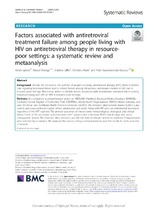| dc.description.abstract | Background: Despite the increase in the number of people accessing antiretroviral therapy (ART), there is limited data regarding treatment failure and its related factors among HIV-positive individuals enrolled in HIV care in resource-poor settings. This review aimed to identify factors associated with antiretroviral treatment failure among individuals living with HIV on ART in resource-poor settings.
Methods: We conducted a comprehensive search on MEDLINE (PubMed), Excerpta Medica Database (EMBASE), Cochrane Central Register of Controlled Trials (CENTRAL), World Health Organization’s (WHO’s) library database, and Latin American and Caribbean Health Sciences Literature (LILACS). We included observational studies (cohort, case- control, and cross-sectional studies) where adolescents and adults living with HIV were on antiretroviral treatment regardless of the ART regimen. The primary outcomes of interest were immunological, virological, and clinical failure. Some of the secondary outcomes were mm3 opportunistic infections, WHO clinical stage, and socio-
demographic factors. We screened titles, abstracts, and the full texts of relevant articles in duplicate. Disagreements were resolved by consensus. We analyzed the data by doing a meta-analysis to pool the results for each outcome of interest.(Continued from previous page)
Results: Antiretroviral failure was nearly 6 times higher among patients who had poor adherence to treatment as compared to patients with a good treatment adherence (OR = 5.90, 95% CI 3.50, 9.94, moderate strength of evidence). The likelihood of the treatment failure was almost 5 times higher among patients with CD4 < 200 cells/ mm3 compared to those with CD4 ≥ 200 CD4 cells/mm3 (OR = 4.82, 95% CI 2.44, 9.52, low strength of evidence). This result shows that poor adherence and CD4 count below < 200 cells/mm3 are significantly associated with
treatment failure among HIV-positive patients on ART in a resource-limited setting. Conclusion: This review highlights that low CD4 counts and poor adherence to ART were associated to ART
treatment failure. There is a need for healthcare workers and HIV program implementers to focus on patients who
have these characteristics in order to prevent ART treatment failure. | en_US |

